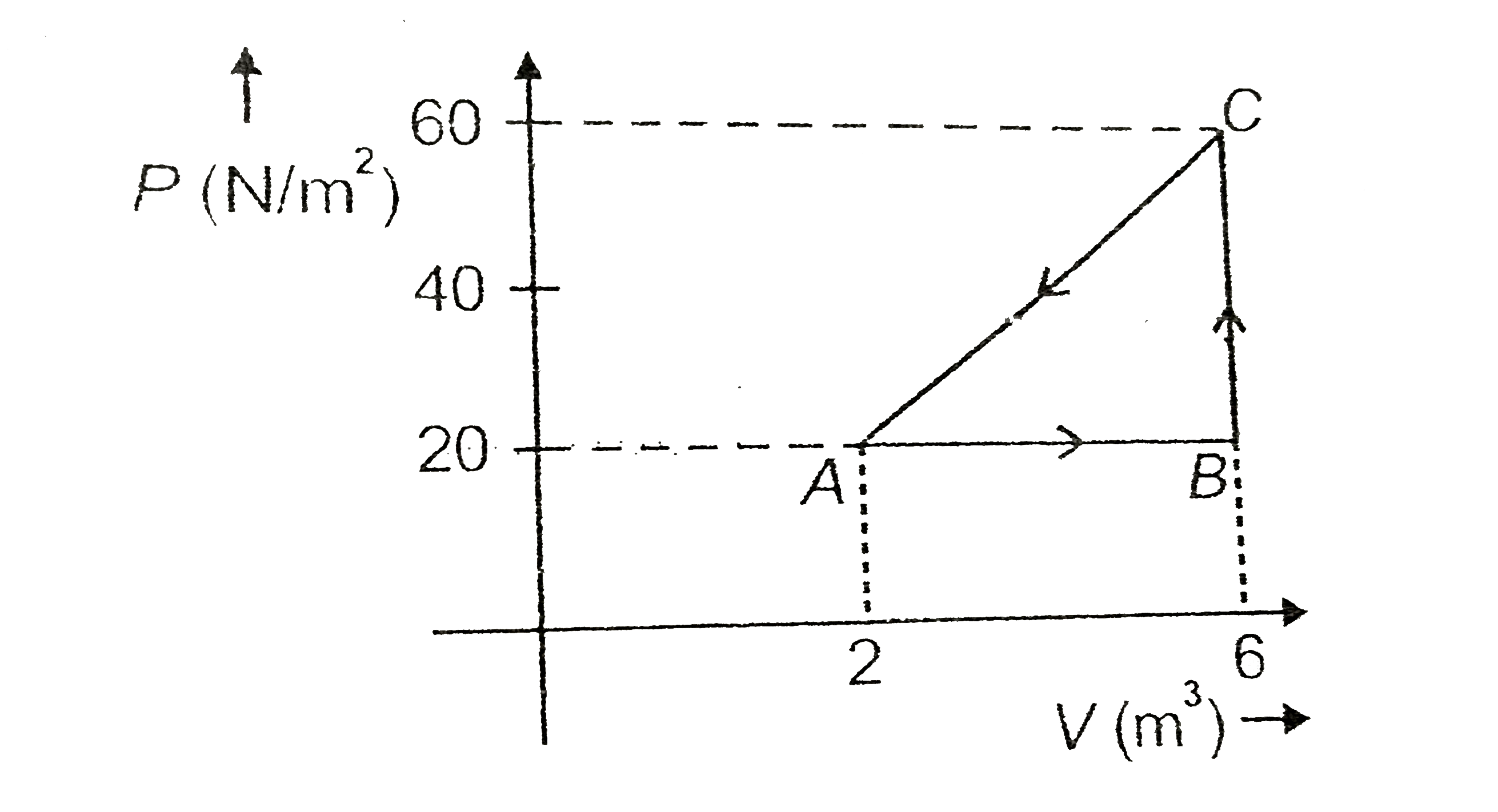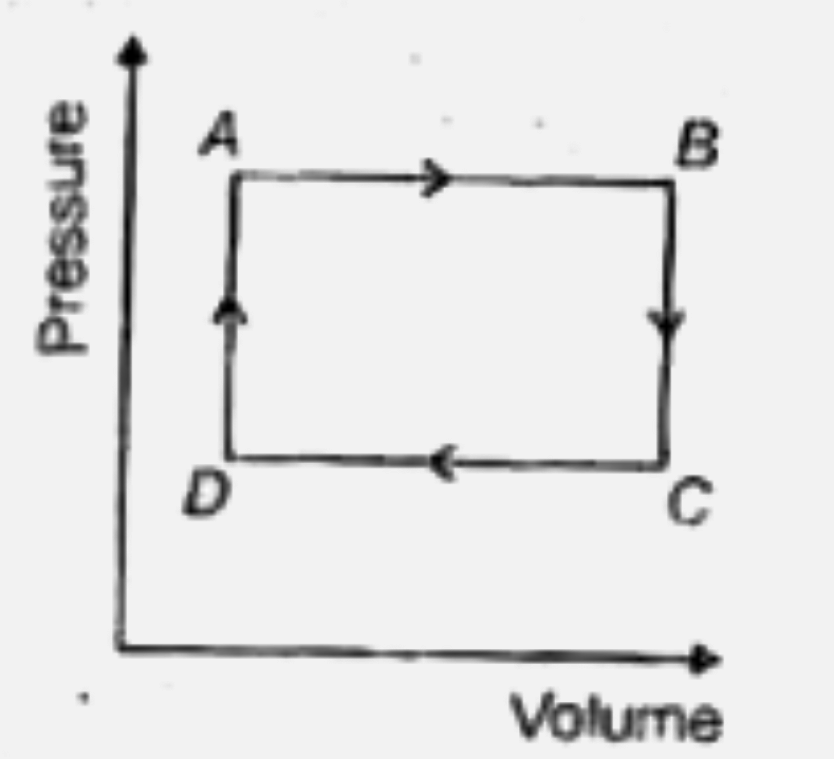Complete Solutions to Example of chapter THERMODYNAMICS of Class 12 book with complete answers and questions
| Class 12 | PHYSICS |
| Chapter | THERMODYNAMICS |
| AAKASH INSTITUTE | Example |
| Number Of Questions | 44 |
| Academic Year | 2023-24 |
When are the two bodies in thermal equilibrium?
View SolutionState true or false, internal energy of a gaseous system depends upon thermodynamic process.
View SolutionFor a gaseous system find change in internal energy if the heat supplied to the system is 50 J and work done by the system is 16 J.
View SolutionValue of `C_(p)` for monatomic gas is `(5)/(2)R`. Find `C_(V)`.
View SolutionChange in internal energy in an isothermal process for ideal gas is
View SolutionIn an adiabatic process
View SolutionState true or false. Work done by an ideal gas in adiabatic expansion is less than that in isothermal process (for same temperature range)
View SolutionThe work done in an ischoric process is
View SolutionWhich of the following is a V-T curve for isobaric process?
View SolutionA carnot engine has efficiency of 60%. If the source is at `527^(@)C`, then find the temperature of sink.
View SolutionFind the efficiency of a carnot engine whose source and sink are `327^(@)C` and `27^(@)C`?
View SolutionA mass of dry air at N.T.P. is compressed to `(1)/(32)` th of its original volume suddenly. If `gamma=1.4` find the final pressure of the gas if initial pressure is P.
View SolutionA cylinder contains 0.50 mol of an ideal gas at temperature of 310 K. as the gas expands isothermally from an initial volume of 0.31 `m^(3)` to a final volume of 0.45`m^(3)`, find the amount of heat that must be added to the gas in order to maintain a constant temperature.

View SolutionA rectangualr box (shown in figure) has a movable and smooth portition which can slide along the length of the box. Both chambers contains 1 mole of monoatomic gas (`gamma=(5)/(3)`) at a pressure walls of box and partition are thermally insulated. Due to heating, gas in left chamber expands until pressure in both chambers become `32P_(0)` determine
(a) The final temperature of gas in each chamber
(b) The work done by the gas in the right chamber.

View SolutionAn ideal gas is made to undergo a process `T = T_(0)e^(alpha V)` where `T_(0)` and `alpha` are constants. Find the molar specific heat capacity of the gas in the process if its molar specific heat capacity at constant volume is `C_(v)`. Express your answer as a function of volume (V).
View SolutionFind the relatio between volume and temperature of a gas in a process, in which the molar heat capacity C varies with temperature T as `C=C_(V)+alphaT`. [`alpha` is a constant] .
View SolutionAn ideal monoactomic gas undergoes a process ini which its internal energy depends upon its volume as
`U=asqrt(V)` [where a is a constant]
(a) find work done by a gas and heat transferred to gas to increse its internal energy by 200 J.
(b) find molar specific heat of gas for this process.
View SolutionAn ideal gas undergoes a cyclic process as shown. Part of the process ab is isothermal expansion and work done by the gas in this expansion is 700 J. in adiabatic expansion be it again does 400 J work. If it rejects 100 J heat when it returns to a from c via b then find efficiency of the cycle.
View SolutionA cyclic process involves three processes: A to B, B to C, C to A, heat exchanges during processes are:
`Q_(AB)=+40J`
`Q_(BC)=+20J`
`Q_(CA)=-10J`
Find net work done and efficiency.
View SolutionFind the possible efficiency of a cycle working between `27^(@)C` and `127^(@)C`.
View SolutionAn ideal gas follows a cyclic process as shown in figure. Internal energy of gas at point A is 10 J while at B is 70 J. the heat absorbed by gas in BC is 120 J.
(a) How much heat is absorbed in process AB?
(b) Find heat energy rejected or absorbed by gas in process CA.
View SolutionWhat is the essential condition for thermodynamic equilibrium?
View SolutionThe figure shows a P.V graph of the thermodynamic behavious of an ideal gas. Find out form this graph (i) work done by the gas in the process `A to B, B to C, C to D and D to A`. (ii) work done by the gas in complete cycle `A to B to C to D to A`.

View SolutionConsider the process on a system as shown in the figure. During the process, the work done by the system

View SolutionFind the net work done during the cycle abc.

View SolutionFind the work done during the perfectly circular cyclic process as shown in the diagram.

View SolutionFor a gaseous system find change in internal energy if the heat supplied to the system is 50 J and work done by the system is 16 J.
View SolutionValue of `C_(p)` for monatomic gas is `(5)/(2)R`. Find `C_(V)`.
View SolutionA gas undergoes expansion in such a mannerthat its p-V diagram plot is a downward sloping straight line as shown in the figure below. What happens to the temperature during the process ?

View SolutionThe pressure and volume of a gas are changed as shown in the p-V diagram in the figrue ahead. The thmperature of the gas

View SolutionThe pressure `(10^(5) Nm ^(-2))` of air filled in a vessel is decreased adiabatically so as to increase its volume three times. Calculate the pressure of air. Given `gamma-`for air = 1.4
View SolutionA tyre pumped to a pressure `3.375 atm "at" 27^(@)C` suddenly bursts. What is the final temperature `(gamma = 1.5)`?
View SolutionIn the following plots match I,II, III,Iv with (a) isothermal process and Adiabatic process for (b) monatomic, (c ) diatomic and (d) triatomic gases respectively.

View SolutionA thermodynamical process is shown in the figure with `p_A=3xxp_(atm)`, `V_A=2xx10^-4m^3`, `p_B=8xxp_(atm)`, `V_C=5xx10^-4m^3`. In the process AB and BC, 600J and 200J heat are added to the system. Find the change in internal energy of the system in the process CA. `[1 p_(atm)=10^5N//m^2]`

View SolutionHeat is supplied at constant pressure to diatomic gas. The part of this heat which goes to increase its internal energy will be
View Solution70 calories of heat required to raise the temperature of 2 moles of an ideal gas at constant pressure from `30^@Cto 35^@C.` The amount of heat required (in calories) to raise the temperature of the same gas through the same range `(30^@C to 35^@C)` at constant volume is:
View SolutionN moles of a monotomic gas is carried round the reversible rectangular cycle ABCDA as shown in the diagram. The temperature at A is `T_sigma`. The thermodynamic efficiency of the cycle is

View SolutionOn a volume-temperature diagram a process 1-2 is an upward sloping straight line having the tendency to ct the volume axis as shown in the figure ehead. During this process the preseure

View SolutionGiven here is a cyclic process on P -V diagram. Process 1-2 is isothermal, 2-3 is isobaric and 3-1 is an isochoric process. Plot this T - P diagram.

View SolutionA particular cyclic process on a P-V diagram is a rectangle as shown below. Plot it on (a) T-V and P-T diagram.

View SolutionA carnot engine takes in 3000 kcal of heat from a reservoir at `627^@C` and gives a part of it to a sink at `27^@C`. The work done by the engine is
View SolutionA scientist chaims to have developed 60% effcient engine while working between`27^@C and 327^@C`. Does he claim right ?
View SolutionThe efficiency of a Carnot's engine at a particular source and sink temperature is `(1)/(2)` .When the sink temperature is reduced by `100^(@)C`, the engine efficiency, becomes `(2)/(3)`. Find the source temperature.
View SolutionAn ideal refrigerator runs between `-23^(@)C` and `27^(@)C`. Find the heat regected to atomosphere for every joule of work input.
View Solution
Example questions and complete solutions for chapter THERMODYNAMICS of AAKASH INSTITUTE ENGLISH of Class 12
All Exercises from AAKASH INSTITUTE Class 12 PHYSICS THERMODYNAMICS
- ASSIGNMENT (SECTION -A) (Objective Type Questions)
- ASSIGNMENT (SECTION -B) (Objective Type Questions)
- ASSIGNMENT (SECTION -C) (Previous Year Questions)
- ASSIGNMENT (SECTION -D) (Assertion - Reason Type Questions)
- Assignment (Section-A) Objective Type Questions (one option is correct)
- Assignment (Section-B) Objective Type Questions (one option is correct)
- Assignment (Section-C) Objective Type Questions (More than one option are correct)
- Assignment (Section-D) Linked comprehension Type questions
- Assignment (Section-E) Assertion-Reason Type Questions
- Assignment (Section-F) Matrix-Match type Question
- Assignment (Section-G) Integer Answer Type Questions
- Assignment (Section-H) Multiple True-False Type Question
- Assignment (Section-I) Subjective Type
- Assignment (Section-J) Aakash Challengers Questions
- Example
- EXERCISE
- TRY YOURSELF
- Try Youself